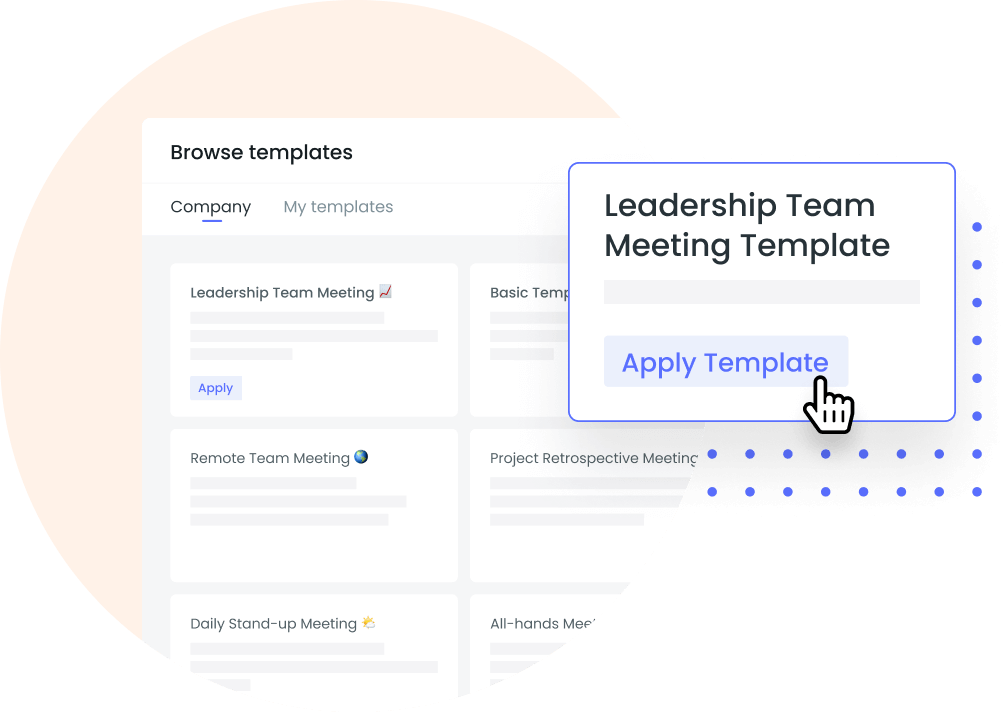13 Calendar Habits for Better Time Management
Leverage some of these 13 easy calendar habits to get more done every day, such as calendar blocking, color coding, and using tools.
If you’ve ever heard of the butterfly effect, you might know that small changes in your life can make a huge impact. At work, you can apply this theory by switching up a few of your calendar habits to make your days a lot more productive! Here, we’ll dive into 13 of the easiest calendar habits for you to integrate into your daily routine.
13 calendar habits for better time management
- Use Fellow for every meeting
- Block out personal time
- Use meeting templates
- Set reminders
- Plan for the long term
- Stick to routines
- Sync your calendars
- Schedule breaks
- Write detailed calendar descriptions
- Color code for efficiency
- Regularly review your calendar
- Leverage integrations
- Avoid back-to-back meetings
1Use Fellow for every meeting
Fellow is a meeting management software that integrates with your calendar to help you and your team gather to have productive team meetings and meaningful 1:1s, build collaborative meeting agendas, record decisions, and keep each other accountable. Before every meeting, users create a collaborative agenda that is distributed to all participants of the call. This ensures that the purpose of the meeting is clearly defined and worthwhile. As well, having a shared agenda allows everyone to contribute talking points to make sure that the time spent together is productive and meets everyone’s needs. During the call, the meeting note-taker can track decisions and action items so the team has a clear path forward.

Seamlessly link your meeting notes with your calendar events
Boost meeting preparation, productivity, and accountability with Fellow’s Google Calendar integration. Access your meeting notes directly from Google Calendar events and stay organized.

2Block out personal time
When a lot is going on at work, it’s easy to lose track of your work-life balance. If you need to step out of work for an appointment or family event, make sure to block the time in your calendar. Not only does this help you maintain a good work-life balance, which prevents burnout, but it also communicates your availability to your teammates so you don’t get double booked. If you’re working with a company that allows flexible start and end times each day, try adding your working hours to your calendar so your wider team knows when you’ll be available.
3Use meeting templates
Meeting templates are a great way to get your collaboration time organized. This is especially true if you’re new to using a meeting agenda and aren’t sure how to run a specific type of call in a structured format. Anyone can make use of meeting templates as there are variations that work for brainstorming, budget planning, C-level review meetings, one-on-ones and more! Access to Fellow’s full library of templates so that when you’re building your meeting agendas, you can directly copy and paste a template that you like or use a combination of templates for inspiration.
4Set reminders
Regardless of if you’re working virtually or in person, it’s easy to lose track of time right before an important call. To make sure you’re never late, set reminders that will notify you ahead of time. In most cases, reminders are set 30 or 15 minutes in advance. Leveraging reminder notifications can also be an excellent way to make sure you don’t run over on a prior call, making you late for the next meeting. If you set reminders 5 or 10 minutes before the next call, you’ll know when to start wrapping up your current meeting and make sure you’re on time for both events.
5Plan for the long term
Have any repeat events in your role? For example, if you know that your reports are due to your boss on the 1st of every month, you can schedule this as a repeat event in your calendar. Better yet, you can also set a calendar event to start working on the report collections a few days in advance. Setting up calendar items like repeat events or time blocks far in advance makes sure you’ll still have time to prioritize those tasks when things start getting busier closer to the actual date.
6Stick to routines
Decision fatigue is real, and it’s common! One way to prevent decision fatigue is to stick to a routine. A good calendar tip for sticking to a routine is to use the calendar blocking method. This method blocks certain times in your calendar for particular tasks, which creates a recurring routine. For example, Mark Zuckerberg, Founder and CEO of Meta, even shared in an early career interview why he only wears the same shirt every day. He said,
“I really want to clear my life to make it so that I have to make as few decisions as possible about anything except how to best serve this community. There’s actually a bunch of psychology theory that even making small decisions, around what you wear or what you eat for breakfast or things like that, they kind of make you tired and consume your energy.”
7Sync your calendars
If you work in a large team or frequently have meetings together, it’s a good idea to sync your calendars. Meeting scheduling tools like Calendy can help you identify common times for the group to meet. This way, you save a lot of manual time scouring calendars for mutual availability! Syncing your calendars allows you to easily share collaborative meeting agendas and see your coworkers’ availability at a glance as well. For sales teams, sharing your calendar also makes it easier for managers to distribute inbound leads to the reps who have the most availability.
8Schedule breaks
Unfortunately, a lot of people who don’t schedule breaks never get them, and this is even more true for meeting-heavy roles like project management, consulting, customer success, marketing, and sales teams. Breaks are necessary to ensure you don’t burn out. Taking a short walk or fitting in a yoga session can also improve your creativity and mental agility, making you a much more productive employee. If you’re looking for a way to balance deep focus time with scheduled breaks, take a look at the Pomodoro Technique for time management!
9Write detailed calendar descriptions
Calendar descriptions help you remember what the purpose of the meeting is. If you’re planning events far in advance or with a lot of stakeholders, this is an easy way to ensure meeting attendees know why the meeting was set. In your calendar event descriptions, try to include:
- The meeting purpose
- Any known talking points (or the meeting agenda, if it’s set already)
- The goals of the meeting
- Information about preparation or documentation to read ahead of the call
10Color code for efficiency
If you’re in a meeting-heavy role, color coding can be a great way to visually organize your schedule. It’s also a great calendar habit for anyone who is overseeing another team member’s role, such as an executive assistant! You can choose to color code based on anything you want. For example, you could have a unique color for each department (like engineering), person (like CFO), or type of calendar event (like focus time, customer check-in call, or internal team meeting). This will be very flexible depending on the purpose of your role and what you’re responsible for organizing.
11Regularly review your calendar
Organizing your calendar can be a quick exercise, especially if you’ve practiced other calendar habits that make it visually easy to oversee (such as color coding or adding meeting agendas to every event invite). Some people prefer to review their calendar at the start of the week to mentally prepare for what’s to come—doing so can also help to ensure you’re not going to miss any due dates that week—but you should also review your calendar at the start of each day for the same reason. If you want to be really proactive, you can also do the review each Friday to prepare for the next week or do a review at the start of each month.
12Leverage integrations
Most calendar tools have just enough features to make them usable without being overbearing. So if you need some extra functionality, try setting up an integration! As an example, Fellow’s app integrates directly into major video conferencing software like Google Meet, Zoom, and Microsoft Teams, so you don’t even need to leave the call to view the agenda or take meeting notes. A lot of customer relationship management (CRM) platforms can also integrate with calendar management tools to make scheduling across big teams easy.

13Avoid back-to-back meetings
When possible, avoid booking back-to-back meetings. With a jam-packed schedule, you limit your ability to take breaks to eat, use the washroom, or even get a bit of mental clarity. Some calendar management solutions have settings that prevent guests from booking back-to-back meetings with you. Instead, try to get at least 15 to 30 minutes between each call. The additional time between meetings also gives you a chance to finish up taking notes, send follow-up documentation, and move action items into your task management platform.
Parting advice
Setting great calendar habits doesn’t take a whole lot of effort, but it does take a lot of consistent practice. Being thoughtful about building good scheduling practices early in your role will give you a solid foundation for the rest of your career. With a bit of effort, you can use these tips to achieve benefits such as improved work-life balance, increased creativity, higher motivation, fewer project delays, and better team alignment—all of which will make you feel more confident and productive in your role!












